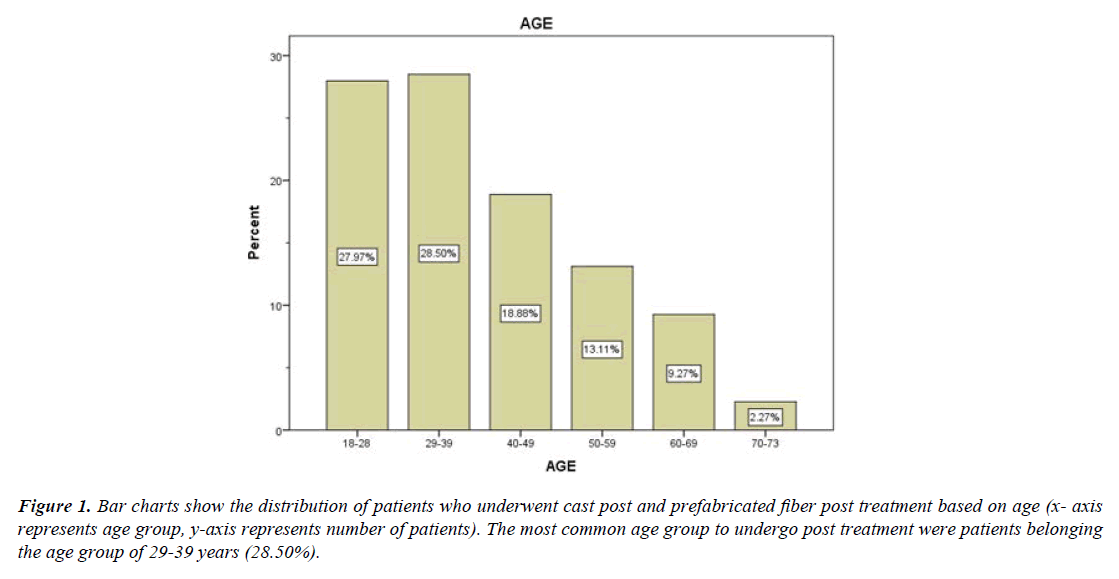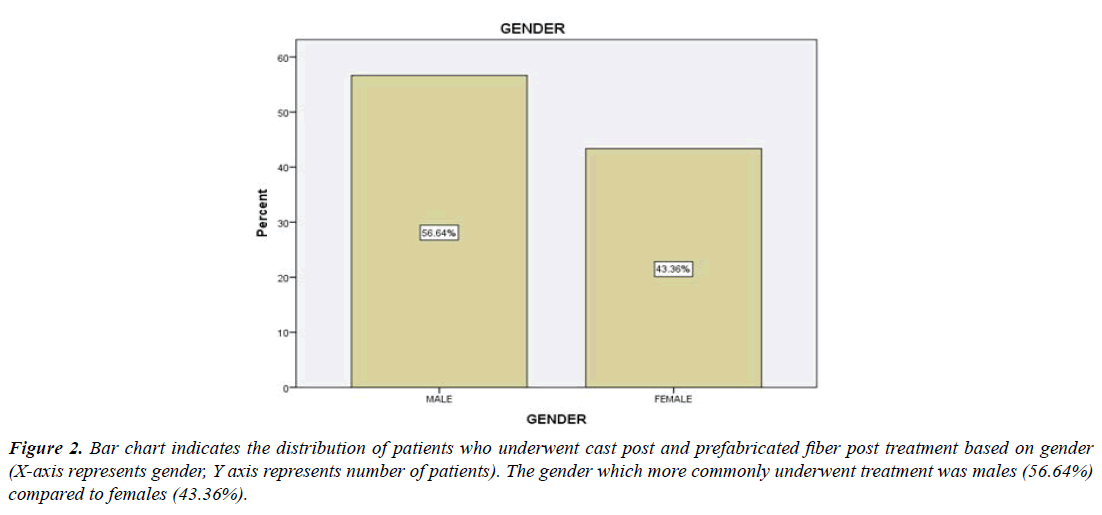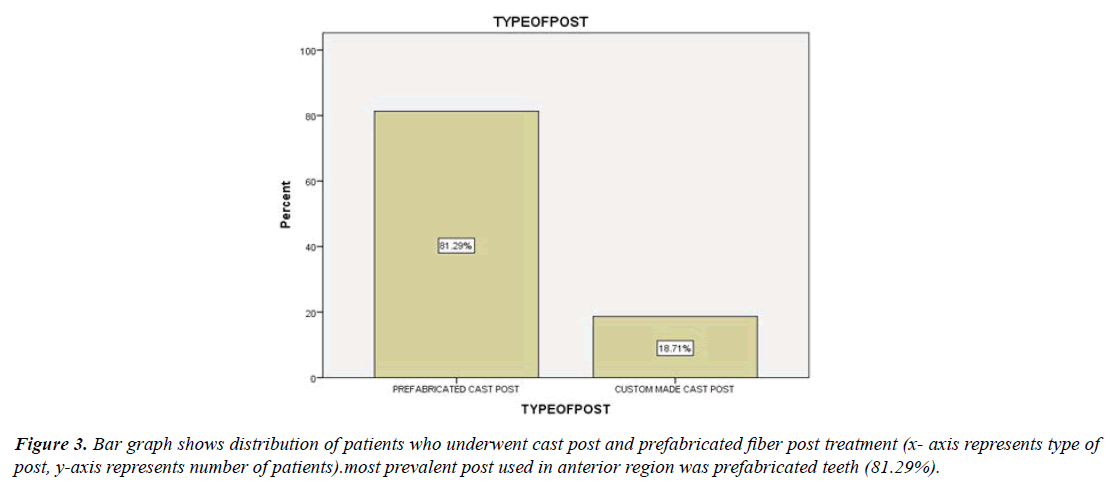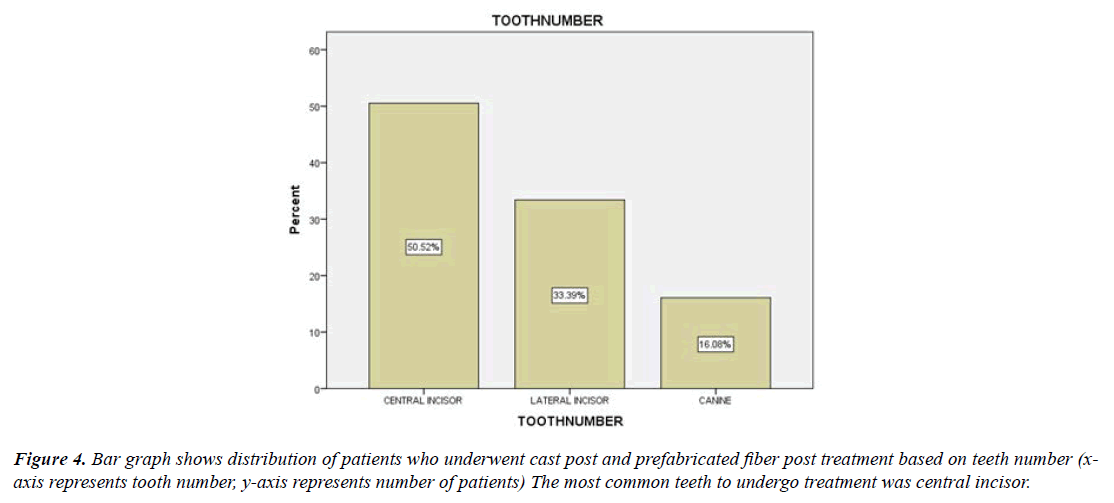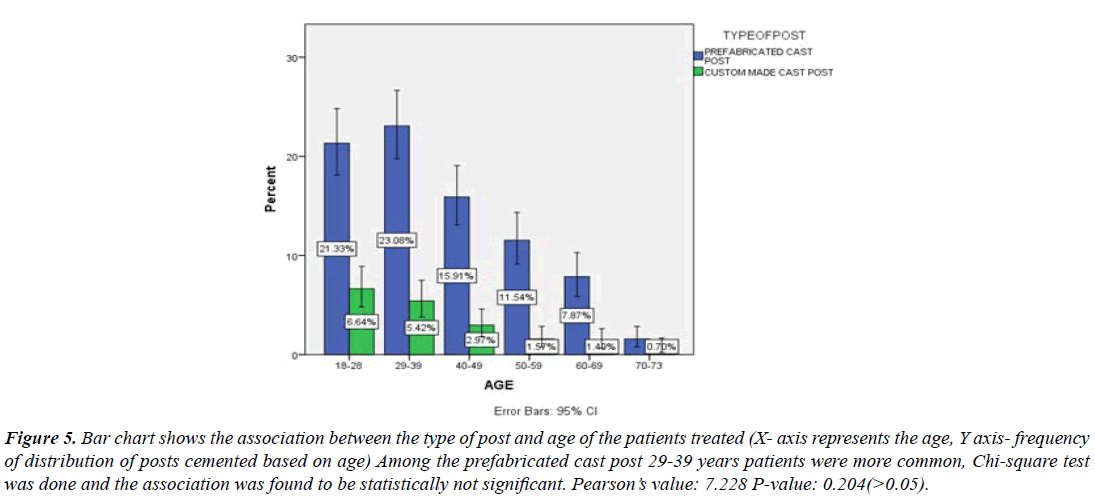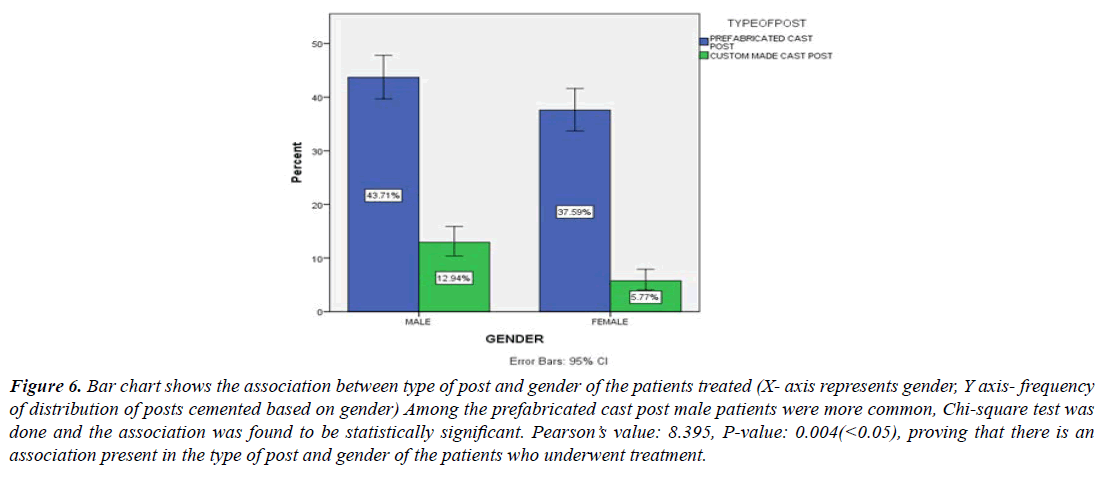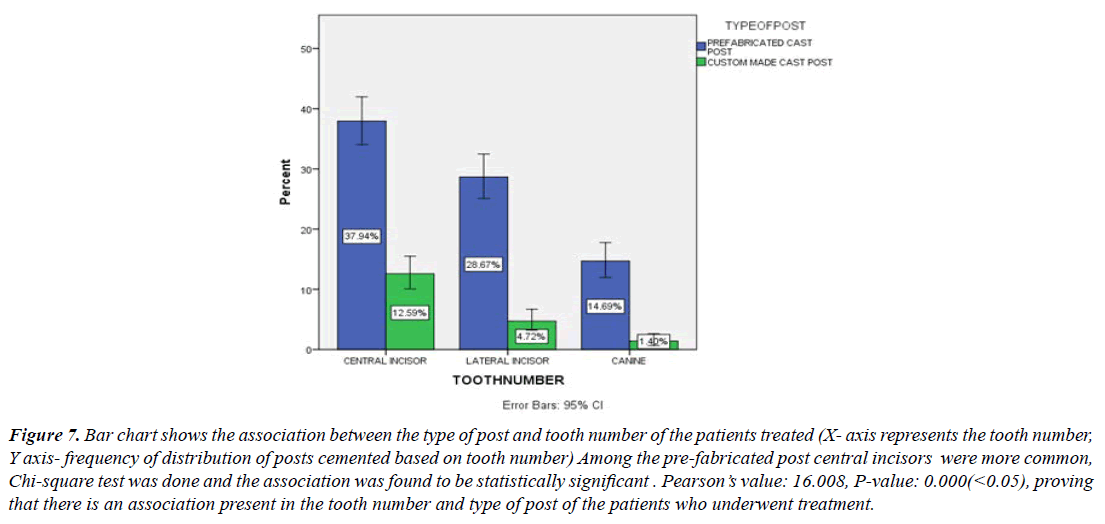Research Article - Journal of Clinical Dentistry and Oral Health (2023) Volume 7, Issue 1
Prevalence Of Cast Post Vs Prefabricated Post In Restoring The Upper Anterior Tooth Post Root Canal Treatment
Vigneshwar.T*, Sathiyamoorthy SDepartment of Conservative Dentistry and Endodontics, Saveetha University, Chennai, India
- *Corresponding Author:
- Vigneshwar.T
Department of Conservative Dentistry and Endodontics
Saveetha University, Chennai, India
E-mail: vigneshwart.sdc@saveetha.com
Received: 29-Dec-2022, Manuscript No. AACDOH-22-84043; Editor assigned: 30-Dec-2022, PreQC No. AACDOH-22-84043(PQ); Reviewed: 13-Jan-2023, QC No AACDOH-22-84043; Revised: 17-Jan-2023, AACDOH-22-84043(R); Published: 24-Jan-2023, DOI:10.35841/aacdoh-7.1.133.
Citation: Vigneshwar T, Sathiyamoorthy S. Prevalence of cast post vs. prefabricated post in restoring the upper anterior tooth post root canal treatment. J Clin Dent Oral Health. 2023;7(1):133
Abstract
Aim: To determine the prevalence of cast post vs prefabricated post in restoring the upper anterior tooth post root canal treatment. Introduction: The endodontically treated teeth with extensive loss of tooth substance have numerous problems due to significant reduction in the capability to resist a myriad of functional forces Today, it is accepted clinical practice to use a post to retain the coronal restoration after a tooth has been endodontically treated when significant amounts of the coronal tooth structure is missing Materials and Methods: The retrospective study was conducted in a university setting. Data was collected from the patients who visited Saveetha dental college between June 2019 to February 2021. Among 573 patients who had reported to the department of conservative dentistry and endodontics of saveetha dental college, prevalence of cast post vs prefabricated post in restoring the upper anterior tooth post root canal treatment were calculated. Results: It was noted that the most common age group to undergo treatment for cast post and prefabricated fiber post were patients in the age group of 29-39 years (28.50%) the most prevalent gender to undergo this treatment was Male (56.64%), most prevalent post used in anterior region was prefabricated teeth (81.29%), most prevalent teeth to be treated was central incisor (50.52%). Conclusion: Within the limitations of the study, it can be concluded the prevalence of prefabricated fiber post in the central incisor was most commonly seen in males than females. Significant association was present between the gender and tooth number with type of post.
Keywords
Cast post, Prefabricated post, Endodontically treated teeth.
Introduction
Dental caries and non-carious lesions is the most common cause for the loss of enamel in a clinical situation [1,2]. Disease of the pulp can be infectious or inflammatory. In such conditions, the healthy pulp attempts to counteract the inflammatory response as a defense mechanism in order to restore the integrity of the pulp [3-5].
Pathophysiology of spread of infection in the root canal is quite complex, the degradation of matrix during dental caries or injury which if not treated early will lead to inflammatory pulpal destruction [6-9]. The teeth which are infected till the pulp are endodontically treated. Following endodontic treatment the final restoration is given, in cases where there is inadequate amount of tooth structure present then the use of post and core build up is done. The use of a post crown fabricated from gold or silver to restore a root-filled tooth was described more than 20 years ago but [10-12]. Today, it is accepted clinical practice to use a post to retain the coronal restoration after a tooth has been endodontically treated when significant amounts of the coronal tooth structure is missing [13-16]. With the advent of new technology, numerous prefabricated post systems have been introduced and used successfully in clinical situations, they have reduced chair time and the cost to the patient [17-20].
Following root filling, the custom-made cast metallic post and core with metal-ceramic crowns was the traditional restoration of choice but this has changed [21-24]. The patients’ primary motivation for seeking superior dental aesthetics, particularly in the anterior aesthetic zone, has prompted the development of non-metallic restorations [25-28]. Several new types of polymeric and more aesthetic quartz and glass-fibres posts, combined with direct resin composite cores, provide an aesthetic foundation for an all-ceramic crown and have overcome the aesthetic limitations of metallic posts and cores in the anterior teeth. Until recently, there has been controversy in the dental community regarding which material or technique is the most favourable for the restoration of ETT [29-31]. It seems that the amount and retentive capacity of the remaining tooth structure, the position of the tooth in the dental arch, the functional or Para-functional loading on the tooth, and the treatment plan to restore aesthetics and function all influence the selection of the most appropriate post system for each case [32-35].
Classification of endodontic posts has been made into 2 groupscustom- made, laboratory-fabricated and prefabricated, directplacements. Prefabricated posts have been made from metals, ceramics, and fiber reinforced, resin-based substrates [36- 39]. Cements for prefabricated posts include zinc phosphate, polycarboxylate, glass ionomer, and resin. Metal posts had been considered gold standard for many years, nonmetallic posts have been introduced to address the need for a more esthetic material in the anterior region [40-44]. The placement of a metal post in the anterior region can cause shadowing of the soft tissues adjacent to the root surface, which might affect the esthetic results required for bonded resin and ceramic restorations in the anterior region [45-47].
Factors that determine the success of post and core treatment includes shape of the canal, chemicals that cause loss of tooth structure type of irrigants used, irrigant activation used, reason for root canal treatment like trauma, preoperative considerations of infected /traumatised teeth, calcified canal, materials used for sealing the root canals [48,49].
Our team has extensive knowledge and research experience that has translated into high quality publications [2,3,6-16,25- 28,36-44,50]. The aim of the study is to find the prevalence of cast post vs prefabricated post in restoring the upper anterior tooth post root canal treatment.
Materials and Methods
Study Design and Setting
The retrospective study was conducted in a university hospital setting and the available data with similar ethnicity was collected from a particular geographic location. The trends in other locations were not assessed in this study setting. Ethical approval was given by the institutional ethical committee. The retrospective study was conducted in a university setting. Data was collected from the patients who visited saveetha dental college between June 2019 to February 2021. Among 573 patients who had reported to the department of conservative and endodontics of Saveetha Dental College, prevalence of cast post vs prefabricated post in restoring the upper anterior tooth post root canal treatment were collected. From this data age, gender, type of post, tooth number was recorded. Case sheets were reviewed and cross verification was done by another examiner to avoid errors.
Statistical analysis
Data was recorded in Microsoft Excel (version 2007, office 365) and later exported to IBM SPSS (version 20.0 Chicago, USA) and subjected to Statistical analysis. Chi Square test was then employed with a level of significance set at P<0.05. Chi square test was done to compare the parameters. The outcome was represented in a form of tables and bar charts.
Result and Discussion
It was noted that the most common age group to undergo treatment for cast post and prefabricated fiber post were patients in the age group of 29-39 years (28.50%) (Figure 1) the most prevalent gender to undergo this treatment was Male (56.64%) (Figure 2), most prevalent post used in anterior region was prefabricated teeth (81.29%) (Figure 3), most prevalent teeth to be treated was central incisor (50.52%) (Figure 4) Correlation between the patient age and the type of post were not statistically significant (p=0.204) (Figure 5) correlation between gender and the type of post-statistically significant (p=0.004) (Figure 6) correlation between the tooth number and the type of poststatistically significant (p=0.000) (Figure 7).
Figure 1: Bar charts show the distribution of patients who underwent cast post and prefabricated fiber post treatment based on age (x- axis represents age group, y-axis represents number of patients). The most common age group to undergo post treatment were patients belonging the age group of 29-39 years (28.50%).
Figure 2: Bar chart indicates the distribution of patients who underwent cast post and prefabricated fiber post treatment based on gender (X-axis represents gender, Y axis represents number of patients). The gender which more commonly underwent treatment was males (56.64%) compared to females (43.36%).
Figure 5: Bar chart shows the association between the type of post and age of the patients treated (X- axis represents the age, Y axis- frequency of distribution of posts cemented based on age) Among the prefabricated cast post 29-39 years patients were more common, Chi-square test was done and the association was found to be statistically not significant. Pearson’s value: 7.228 P-value: 0.204(>0.05).
Figure 6: Bar chart shows the association between type of post and gender of the patients treated (X- axis represents gender, Y axis- frequency of distribution of posts cemented based on gender) Among the prefabricated cast post male patients were more common, Chi-square test was done and the association was found to be statistically significant. Pearson’s value: 8.395, P-value: 0.004(<0.05), proving that there is an association present in the type of post and gender of the patients who underwent treatment.
Figure 7: Bar chart shows the association between the type of post and tooth number of the patients treated (X- axis represents the tooth number, Y axis- frequency of distribution of posts cemented based on tooth number) Among the pre-fabricated post central incisors were more common, Chi-square test was done and the association was found to be statistically significant . Pearson’s value: 16.008, P-value: 0.000(<0.05), proving that there is an association present in the tooth number and type of post of the patients who underwent treatment.
The availability of new aesthetic prefabricated fibre post systems has created the need for a systematic evaluation of their physical properties and clinical performance. For direct buildup of the coronal tooth structure after luting a fibre post, many types of resin composite materials have been proposed. Many different types of posts have been mentioned in the literature [51,52]. At first, cast metal alloy posts and prefabricated posts made of stainless steel, titanium or precious alloys were used. This cast post core system was more time consuming and required an intermediate laboratory phase to elaborate the retaining system, making the procedure expensive. Prefabricated posts did not require the laboratory phase and, therefore, allowed the whole restoration to be performed in one visit, resulting in an easier and less expensive technique.
These newer systems, fibre post have focused on physical properties, such as modulus of elasticity, that are closely matched to dentin to decrease stress concentration within the root canal and reduce the incidence of fracture , The indication for post placement depends on ascertaining the amount of destruction exhibited and whether the remaining tooth structure will support the selected restoration. The main factors that determine the prognosis of restored pulpless teeth have been the preservation of healthy dentin, the ferruling of crown margins on sound tooth structure, and the type of intermaxillary relation. Since in most cases there is no sound tooth structure it is generally not indicated to use veneers for anterior teeth replacement. A veneer is a thin sheet of material placed on the front surface of the tooth, used for aesthetic purposes and protection. It is usually a thin layer of restorative material replacing the enamel [53-55]. Fiber-reinforced composite posts are indicated when restoring endodontically treated teeth to provide retention of the core and for root reinforcement.
Conclusion
Within the limitations of the study, it can be concluded the prevalence of prefabricated fiber post in the central incisor was most commonly seen in males than females. Significant association was present between the gender and tooth number with type of post. Prefabricated fibre posts and all-ceramic restorations offer a promising alternative to the restoration of anterior ETT with cast metallic posts and porcelain fused to metal crowns.
Conflict of Interest
None to declare.
Acknowledgements
I would like to show our gratitude to the Director of Academics, DR. Deepak Nallasamy Veeraiyan, Saveetha Institute of Medical and Technical Sciences, for sharing his pearls of wisdom with us during the course of this research, and we thank the reviewers for their so called insights. We are also immensely grateful to the Department of Conservative Dentistry and Endodontics, Saveetha Dental College for their comments on an earlier version of the manuscript, although any errors are our own and should not tarnish the reputations of these esteemed persons.
Source of Funding
The present study was supported by the following agencies:
✓ Saveetha Dental College, Saveetha Institute of Medical and Technical Science, India
✓ Sarkav Healthcare services
References
- Morgano SM, Brackett SE. Foundation restorations in fixed prosthodontics: Current knowledge and future needs. J Prosthet Dent. 1999;82(6):643-57.
- Muthukrishnan L. Imminent antimicrobial bioink deploying cellulose, alginate, EPS and synthetic polymers for 3D bioprinting of tissue constructs. Carbohydr Polym. 2021;260:117774.
- Bateman G, Ricketts DN, Saunders WP. Fibre-based post systems: A review. Br Dent J. 2003;195(1):43-8.
- Stewardson DA. Fibre-based post systems: a review of the literature. Br Dent J. 2003;195(1):37.
- Ricketts DN, Tait CM, Higgins AJ. Post and core systems, refinements to tooth preparation and cementation. Br Dent J. 2005;198(9):533-41.
- PradeepKumar A.R, Shemesh H, Nivedhitha M.S, et al. Diagnosis of vertical root fractures by cone-beam computed tomography in root-filled teeth with confirmation by direct visualization: A systematic review and meta-analysis. J Endod. 2021;47(8):1198-1214.
- Aquilino SA, Caplan DJ. Relationship between crown placement and the survival of endodontically treated teeth. J Prosthet Dent. 2002;87(3):256-63.
- Radovic I, Monticelli F, Goracci C, et al. The effect of sandblasting on adhesion of a dual-cured resin composite to methacrylic fiber posts: Microtensile bond strength and SEM evaluation. J Dent. 2007;35(6):496-502.
- Ferrari M. Fiber posts and endodontically treated teeth: A compendium of scientific and clinical perspectives. Mod Dent Med; 2008;172.
- Grandini S, Goracci C, Tay FR, et al. Clinical evaluation of the use of fiber posts and direct resin restorations for endodontically treated teeth. Int J Prosthodont. 2005;18(5).
- Grandini S, Goracci C, Monticelli F, et al. Fatigue resistance and structural characteristics of fiber posts: Three-point bending test and SEM evaluation. Dent Mater. 2005;21(2):75-82.
- Salameh Z, Sorrentino R, Ounsi HF, et al. Effect of different all-ceramic crown system on fracture resistance and failure pattern of endodontically treated maxillary premolars restored with and without glass fiber posts. J Endodont. 2007;33(7):848-51.
- Chakraborty T, Jamal RF, Battineni G, et al. A review of prolonged post-COVID-19 symptoms and their implications on dental management. Int J Environ Res Pub Health. 2021;18(10):5131.
- Muthukrishnan L. Nanotechnology for cleaner leather production: A review. Environ Chem Lett. 2021;19(3):2527-49.
- Teja KV, Ramesh S. Is a filled lateral canal: A sign of superiority? J Dent Sci. 2020;15(4):562.
- Narendran K, MS N, Sarvanan A. Synthesis, Characterization, free radical scavenging and cytotoxic activities of phenylvilangin, a substituted dimer of embelin. India J Pharm Sci. 2020;82(5):909-12.
- Cormier CJ, Burns DR, Moon P. In vitro comparison of the fracture resistance and failure mode of fiber, ceramic and conventional post systems at various stages of restoration. J Prosthodont. 2001;10(1):26-36.
- Sowmya MK. 53. Comparison of the fracture strength of fiber post with peek post–an in vitro study. J Indian Prosthodon Soc. 2018;18(Suppl 2):S73.
- Palepwad AB, Kulkarni RS. In vitro fracture resistance of zirconia, glass-fiber, and cast metal posts with different lengths. J Indian Prosthodon Soc. 2020;20(2):202.
- Heydecke G, Peters MC. The restoration of endodontically treated, single-rooted teeth with cast or direct posts and cores: a systematic review. J Prosthe Dent. 2002;87(4):380-6.
- Caplan D. It is unclear whether endodontically treated; single-rooted teeth need cast or direct post and cores. J Evid Based Dent Pract. 2003;3(1):13-4.
- Cloet E, Debels E, Naert I. Controlled clinical trial on the outcome of glass fiber composite cores versus wrought posts and cast cores for the restoration of endodontically treated teeth: A 5-year follow-up study. Int J Prosthodont. 2017;30(1): 71-9
- Stockton L, Lavelle CL, Suzuki M. Are posts mandatory for the restoration of endodontically treated teeth? Den Traumatol. 1998;14(2):59-63.
- Sawant K, Pawar AM, Banga KS, et al. Dentinal Microcracks after Root Canal Instrumentation Using Instruments Manufactured with Different NiTi Alloys and the SAF System: A Systematic Review. Appl Sci. 2021;11(11):4984.
- Bhavikatti SK, Karobari MI, Zainuddin SL, et al. Investigating the antioxidant and cytocompatibility of Mimusops elengi Linn extract over human gingival fibroblast cells. Int J Environ Res Pub Health. 2021;18(13):7162.
- Karobari MI, Basheer SN, Sayed FR, et al. An in vitro stereomicroscopic evaluation of bioactivity between neo mta plus, pro root mta, biodentine & glass ionomer cement using dye penetration method. Mater. 2021;14(12):3159.
- Rohit Singh T, Ezhilarasan D. Ethanolic extract of Lagerstroemia Speciosa (L.) Pers., induces apoptosis and cell cycle arrest in HepG2 cells. Nutr Cancer. 2020;72(1):146-56.
- Reeh ES, Douglas WH, Messer HH. Stiffness of endodontically-treated teeth related to restoration technique. J Dent Res. 1989;68(11):1540-4.
- Trope M, Maltz DO, Tronstad L. Resistance to fracture of restored endodontically treated teeth. DentTraumatol. 1985;1(3):108-11.
- Tjan AH, Whang SB. Resistance to root fracture of dowel channels with various thicknesses of buccal dentin walls. J Prosthet Dent. 1985;53(4):496-500.
- Zarei M, Afkhami F, Malek Poor Z. Fracture resistance of human root dentin exposed to calcium hydroxide intervisit medication at various time periods: An in vitro study. Dent Traumatol. 2013;29(2):156-60.
- Sidoli GE, King PA, Setchell DJ. An in vitro evaluation of a carbon fiber-based post and core system. J Prosthe Dent. 1997;78(1):5-9.
- King PA, Setchell DJ. An in vitro evaluation of a prototype CFRC prefabricated post developed for the restoration of pulpless teeth. J Oral Rehabil. 1990;17(6):599-609.
- King PA, Setchell DJ, Rees JS. Clinical evaluation of a carbon fibre reinforced carbon endodontic post. J Oral Rehabil. 2003;30(8):785-9.
- Ezhilarasan D. MicroRNA interplay between hepatic stellate cell quiescence and activation. Eur J Pharmacol. 2020;885:173507.
- Raj R K. β-Sitosterol assisted silver nanoparticles activates Nrf2 and triggers mitochondrial apoptosis via oxidative stress in human hepatocellular cancer cell line. J Biomed Mater Res Part A. 2020;108(9):1899-908.
- Vijayashree Priyadharsini J. In silico validation of the non-antibiotic drugs acetaminophen and ibuprofen as antibacterial agents against red complex pathogens. J Periodontol. 2019;90(12):1441-8.
- Romera A, Peredpaya S, Shparyk Y, et al. Bevacizumab biosimilar BEVZ92 versus reference bevacizumab in combination with FOLFOX or FOLFIRI as first-line treatment for metastatic colorectal cancer: a multicentre, open-label, randomised controlled trial. Lancet Gastroenterol Hepatol. 2018;3(12):845-55.
- Priyadharsini JV, Girija AS, Paramasivam A. In silico analysis of virulence genes in an emerging dental pathogen A. baumannii and related species. Arch Oral Biol. 2018;94:93-8.
- Uma Maheswari TN, Nivedhitha MS, Ramani P. Expression profile of salivary micro RNA-21 and 31 in oral potentially malignant disorders. Braz Oral Res. 2020;34(12):55-8
- Gudipaneni RK, Alam MK, Patil SR, et al. Measurement of the maximum occlusal bite force and its relation to the caries spectrum of first permanent molars in early permanent dentition. J Clin Pediatr Dent. 2020;44(6):423-8.
- Chaturvedula BB, Muthukrishnan A, Bhuvaraghan A, et al. Dens invaginatus: a review and orthodontic implications. Br Dent J. 2021;230(6):345-50.
- Kanniah P, Radhamani J, Chelliah P, et al. Green synthesis of multifaceted silver nanoparticles using the flower extract of Aerva lanata and evaluation of its biological and environmental applications. Chem Select. 2020;5(7):2322-31.
- Standlee JP, Caputo AA, Holcomb J, et al. The retentive and stress-distributing properties of a threaded endodontic dowel. J Prosthet Dent. 1980;44(4):398-404.
- Burns DA, Krause WR, Douglas HB, et al. Stress distribution surrounding endodontic posts. J Prosthe Dent. 1990;64(4):412-8.
- Ross RS, Nicholls JI, Harrington GW. A comparison of strains generated during placement of five endodontic posts. J Endodont. 1991;17(9):450-6.
- Larson TD, Jensen JR. Microleakage of composite resin and amalgam core material under complete cast crowns. J Prosthe Dent. 1980;44(1):40-4.
- Balkenhol M, Wöstmann B, Rein C, et al. Survival time of cast post and cores: A 10-year retrospective study. J Dent. 2007;35(1):50-8.
- Davies SJ, Gray RJ, Qualtrough AJ. Management of tooth surface loss. Br Dent J. 2002;192(1):11-23.
- Ibbetson R, Eder A. Tooth surface loss: Editors' introduction. Br Dent J. 1999;186(2):60-76.
- Ferracane JL, Condon JR. Post-cure heat treatments for composites: Properties and fractography. Dent Mater. 1992;8(5):290-5.
- Ferracane JL, Hopkin JK, Condon JR. Properties of heat-treated composites after aging in water. Dent Mater. 1995;11(5-6):354-8.
- Sarkis-Onofre R, Pereira-Cenci T, Opdam NJ, et al. Preference for using posts to restore endodontically treated teeth: findings from a survey with dentists. Bra Oral Res. 2014;29:1-6.
- Pontius O, Hutter JW. Survival rate and fracture strength of incisors restored with different post and core systems and endodontically treated incisors without coronoradicular reinforcement. J Endodont. 2002;28(10):710-5.
- Strub JR, Pontius O, Koutayas S. Survival rate and fracture strength of incisors restored with different post and core systems after exposure in the artificial mouth. J Oral Rehabil. 2001;28(2):120-4.
Indexed at, Google Scholar, Cross Ref
Indexed at, Google Scholar, Cross Ref
Indexed at, Google Scholar, Cross Ref
Indexed at, Google Scholar, Cross Ref
Indexed at, Google Scholar, Cross Ref
Indexed at, Google Scholar, Cross Ref
Indexed at, Google Scholar, Cross Ref
Indexed at, Google Scholar, Cross Ref
Indexed at, Google Scholar, Cross Ref
Indexed at, Google Scholar, Cross Ref
Indexed at, Google Scholar, Cross Ref
Indexed at, Google Scholar, Cross Ref
Indexed at, Google Scholar, Cross Ref
Indexed at, Google Scholar, Cross Ref
Indexed at, Google Scholar, Cross Ref
Indexed at, Google Scholar, Cross Ref
Indexed at, Google Scholar, Cross Ref
Indexed at, Google Scholar, Cross Ref
Indexed at, Google Scholar, Cross Ref
Indexed at, Google Scholar, Cross Ref
Indexed at, Google Scholar, Cross Ref
Indexed at, Google Scholar, Cross Ref
Indexed at, Google Scholar, Cross Ref
Indexed at, Google Scholar, Cross Ref
Indexed at, Google Scholar, Cross Ref
Indexed at, Google Scholar, Cross Ref
Indexed at, Google Scholar, Cross Ref
Indexed at, Google Scholar, Cross Ref
Indexed at, Google Scholar, Cross Ref
Indexed at, Google Scholar, Cross Ref
Indexed at, Google Scholar, Cross Ref
Indexed at, Google Scholar, Cross Ref
Indexed at, Google Scholar, Cross Ref
Indexed at, Google Scholar, Cross Ref
Indexed at, Google Scholar, Cross Ref
Indexed at, Google Scholar, Cross Ref
Indexed at, Google Scholar, Cross Ref
Indexed at, Google Scholar, Cross Ref
Indexed at, Google Scholar, Cross Ref
Indexed at, Google Scholar, Cross Ref
Indexed at, Google Scholar, Cross Ref
Indexed at, Google Scholar, Cross Ref
Indexed at, Google Scholar, Cross Ref
Indexed at, Google Scholar, Cross Ref
Indexed at, Google Scholar, Cross Ref
Indexed at, Google Scholar, Cross Ref
Indexed at, Google Scholar, Cross Ref
Indexed at, Google Scholar, Cross Ref
Indexed at, Google Scholar, Cross Ref
